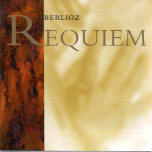In recounting the premiere of his Requiem, Berlioz wrote “the terror inspired […..] was indescribable. One of the female choristers suffered an attack of nerves. It was awesome in its grandeur.” Listening to this new recording by Charles Dutoit and his assembled forces one could hardly believe the piece made anything near that kind of impact. A strange kind of gauze seems to be wrapped around this performance that clogs tempos, mutes colors, and dulls accents throughout the piece. We get the impression that Dutoit, like the clerics in Berlioz’s day, feels that church music should be strictly pious and reverent with no allowance for willful displays of worldly emotion (which exactly describes Berlioz’s artistic ethos).
Dutoit creates a monastic atmosphere in the opening Requiem et Kyrie, and the approach seems plausible enough (it is about “resting in peace” after all) until you realize that this is the conductor’s intention for the entire work–nowhere more so than in the following Dies irae. Without a doubt, this is the dullest Tuba mirum ever! (Tuba borum is more like it!) The brass fanfares are plodding; the drums and chorus enter dutifully, more like a coronation than a day of wrath. After this, listening to Leonard Bernstein’s performance (Sony) is a shock. The fanfares are done with an urgency that only increases right up to the drums and chorus entrance–a terrifying sound!
In section after section of Dutoit’s account the established interpretive pallor presides. This goes for the singing too. John Mark Ainsley’s Sanctus has none of the rapt intensity (or secure high-notes) of Stuart Burrows for Bernstein. And Bernstein’s chorus sings with a fervor that seems completely alien to Dutoit’s group. Perhaps it’s the result of the last 15 years or so of “authentic” performance practice, but to me the Montreal chorus sounds under-energized. This appears to be a Requiem of, rather than for, the dead. The Five Sacred Pieces fare better, especially the ones for a cappella chorus. The Resurrexit, from Berlioz’s early Messe solonnelle, features an infant Tuba mirum which, paradoxically, Dutoit plays with more fervor than the grown-up version. As consolation, the sound is spectacular, assuming you still care.
































